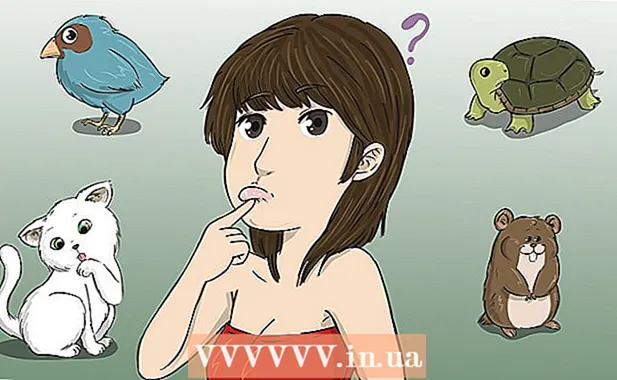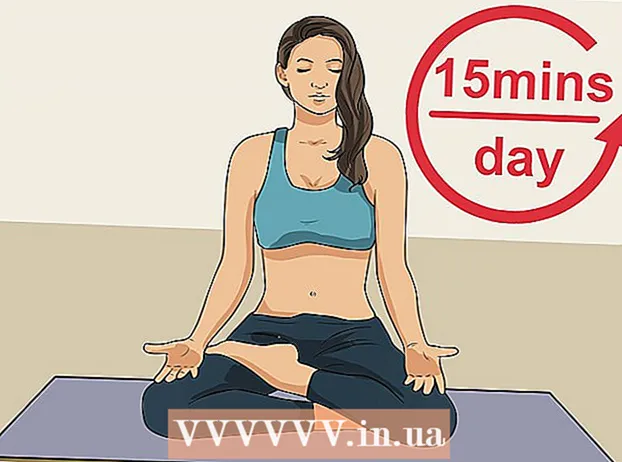Author:
Mark Sanchez
Date Of Creation:
27 January 2021
Update Date:
1 July 2024

Content
- Steps
- Method 1 of 2: Proper Hand Lifting Technique
- Method 2 of 2: Communicate regularly with your guinea pig
- Tips
- Warnings
Guinea pigs, like any other small pets, require gentle and careful handling. When handling your guinea pig, you should always provide support for its hind legs to avoid accidentally injuring its back.
Steps
Method 1 of 2: Proper Hand Lifting Technique
 1 Calmly approach the guinea pig. Animals can sense when a person is nervous.When dealing with animals of any kind, including guinea pigs, you should always remain calm and confident.
1 Calmly approach the guinea pig. Animals can sense when a person is nervous.When dealing with animals of any kind, including guinea pigs, you should always remain calm and confident. - If, for one reason or another, you are unable to maintain calmness, postpone the interaction with the guinea pig until you calm down.
- Try to talk to your guinea pig so that it doesn't get scared when you pick it up.
 2 Grasp the front of the guinea pig with your right hand. You can do this in two different ways. Both are listed below.
2 Grasp the front of the guinea pig with your right hand. You can do this in two different ways. Both are listed below. - Method 1. Place the palm of your right hand on the guinea pig in the shoulder area. Place your thumb behind the forelegs of your pet. Pass the rest of your fingers partly in front of the front legs and partly behind them (for example, place one or two toes in the front and two or three fingers in the back).
- Method 2. Bring your right palm under the pet's chest in the area of the front legs. Place your index finger in front of the pet's front left paw, and the rest behind it. Lock the left foot of the guinea pig between the index and middle fingers.
 3 Don't squeeze your hand. Your right hand should hold the guinea pig firmly, but gently, without any extra pressure. If you begin to squeeze your pet, then he may begin to resist and get injured.
3 Don't squeeze your hand. Your right hand should hold the guinea pig firmly, but gently, without any extra pressure. If you begin to squeeze your pet, then he may begin to resist and get injured.  4 Place your left hand under the guinea pig's butt. When you wrap your right hand around the front of the guinea pig, bring your left hand underneath the back of the guinea pig. In this case, the back of the pet's body must receive full and reliable support.
4 Place your left hand under the guinea pig's butt. When you wrap your right hand around the front of the guinea pig, bring your left hand underneath the back of the guinea pig. In this case, the back of the pet's body must receive full and reliable support.  5 Raise the guinea pig horizontally. Raise the front of the guinea pig slightly in your right hand to lift its legs off the floor. Then start lifting the butt of the guinea pig that you are holding with your left hand. While lifting, be sure to provide support for the pet's hind legs, they should not dangle in the air under any circumstances.
5 Raise the guinea pig horizontally. Raise the front of the guinea pig slightly in your right hand to lift its legs off the floor. Then start lifting the butt of the guinea pig that you are holding with your left hand. While lifting, be sure to provide support for the pet's hind legs, they should not dangle in the air under any circumstances. - If the guinea pig starts to resist when you handle it, you may need to grasp its hind legs in your left hand.
 6 Hold your guinea pig close to your body. As you lift the guinea pig up, bring your hands to your chest and body. Hug your pet when you hold it in your arms and move with it.
6 Hold your guinea pig close to your body. As you lift the guinea pig up, bring your hands to your chest and body. Hug your pet when you hold it in your arms and move with it. - Guinea pigs feel safer if they lean on you with all four legs or snuggle against your body.
Method 2 of 2: Communicate regularly with your guinea pig
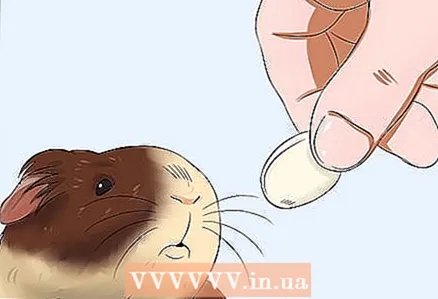 1 Use treats to please your guinea pig. The first time you try to pick up a guinea pig, you will need to first earn its trust. First, let the guinea pig sniff your palm and fingers. Use a treat to lure your pet closer and make him sympathetic.
1 Use treats to please your guinea pig. The first time you try to pick up a guinea pig, you will need to first earn its trust. First, let the guinea pig sniff your palm and fingers. Use a treat to lure your pet closer and make him sympathetic. - Small pieces of fruits such as oranges, plums, berries, grapes, bananas, watermelons, or melons can be used as treats.
- Chunks of some vegetables are also good choices, including basil leaves, turnip greens, bell peppers, romano salad, clover, cucumbers, tomatoes, celery, corn, dandelions, kale, and beetroot.
- The following foods can be used as a treat no more than twice a week: parsley, carrots, and apples.
 2 Handle your guinea pig regularly. The more often you pick up your pet, the stronger your bond with him will be. You should have your guinea pig at least once a day.
2 Handle your guinea pig regularly. The more often you pick up your pet, the stronger your bond with him will be. You should have your guinea pig at least once a day. 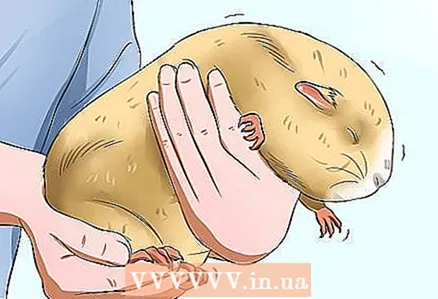 3 Be careful if your guinea pig starts to resist you. Unlike hamsters and gerbils, guinea pigs do not usually bite when frightened. They just start to resist and pull away, hoping that you will let go or leave them.
3 Be careful if your guinea pig starts to resist you. Unlike hamsters and gerbils, guinea pigs do not usually bite when frightened. They just start to resist and pull away, hoping that you will let go or leave them. - If the guinea pig starts to resist in your hands, be careful not to squeeze it too hard in an attempt to tame it.
- If your guinea pig decides to bite, try to position your hands so that it cannot reach them with its teeth.
 4 After interacting with the guinea pig, return it to the cage. When it comes time to return your guinea pig to the floor or cage, know that it can try to jump off your hands. Since such jumps can lead to injuries, you must not allow them, you must yourself lower the guinea pig down.
4 After interacting with the guinea pig, return it to the cage. When it comes time to return your guinea pig to the floor or cage, know that it can try to jump off your hands. Since such jumps can lead to injuries, you must not allow them, you must yourself lower the guinea pig down. - If the guinea pig is not able to see where it is being carried, then the likelihood that it will jump out of hand is reduced.
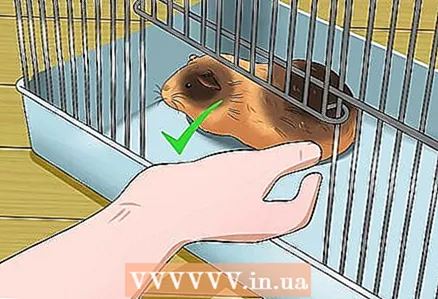 5 Do not let go of your pet until it stops resisting. When you return your guinea pig to its cage, keep it in your hand until it stops struggling. Hold her firmly, but carefully, a few inches off the floor and wait for her to calm down. As soon as attempts to escape stop, place the guinea pig with its paws on the floor. Never let go of her until she stops resisting.
5 Do not let go of your pet until it stops resisting. When you return your guinea pig to its cage, keep it in your hand until it stops struggling. Hold her firmly, but carefully, a few inches off the floor and wait for her to calm down. As soon as attempts to escape stop, place the guinea pig with its paws on the floor. Never let go of her until she stops resisting.  6 Don't hold your guinea pig for too long. Even a very sociable guinea pig will eventually want to get off his hands and onto the floor. She may want to use the toilet or just retire in a cage. If you notice that the guinea pig starts to behave restlessly in his arms and periodically licks them, then perhaps she wants to go down.
6 Don't hold your guinea pig for too long. Even a very sociable guinea pig will eventually want to get off his hands and onto the floor. She may want to use the toilet or just retire in a cage. If you notice that the guinea pig starts to behave restlessly in his arms and periodically licks them, then perhaps she wants to go down. - If the guinea pig licked your hand and then calmed down, then she's fine. But if she licks your hand for a long time and constantly resists, then most likely she wants to go back to the cage.
- On average, guinea pigs like to spend no more than 10-20 minutes in their arms at a time.
- If you hold your guinea pig for too long, it may pee or poop in your arms. In case of an emergency, you can lay a towel on your lap and put your guinea pig on it.
Tips
- If you have more than one guinea pig, handle only one at a time.
- Be sure to use both hands when lifting your guinea pig.
- Always be sure to hold your guinea pig securely before lifting it above 2.5–5 cm from the floor. If the guinea pig is running on the floor of the room, it will be more convenient for you to first squat or bend over it and only then pick it up and stand up.
- Make sure your pig always has hay and feed.
- Guinea pigs are fragile creatures and usually do not like touching sensitive parts of the body. Before stroking your pig, see how it reacts to stroking in different places.
Warnings
- Not all guinea pigs enjoy being handled. Some of them prefer to stay on the floor with all four paws. While it is great to grab your furry friend in your arms, if your pet continues to resist you after a few tries, take a short break. When your guinea pig doesn't like to sit in your arms at all, you can cause stress and anxiety in your guinea pig if you handle it too often.
- Do not put your guinea pig next to your hamster or it will try to kill it. If you are holding both a guinea pig and a hamster, there should be a safe distance between them. Place their cages away from each other.
- Since the guinea pig requires careful handling and the use of two hands when it is lifted, it is best to trust this pet to grown-up children and adults. Young children can be allowed to play with the guinea pig on the floor and pet it while in the arms of an adult.
- If your guinea pig is late in pregnancy, it is best not to handle it at all. Whenever you need to move it from one place to another, use a box or basket.
